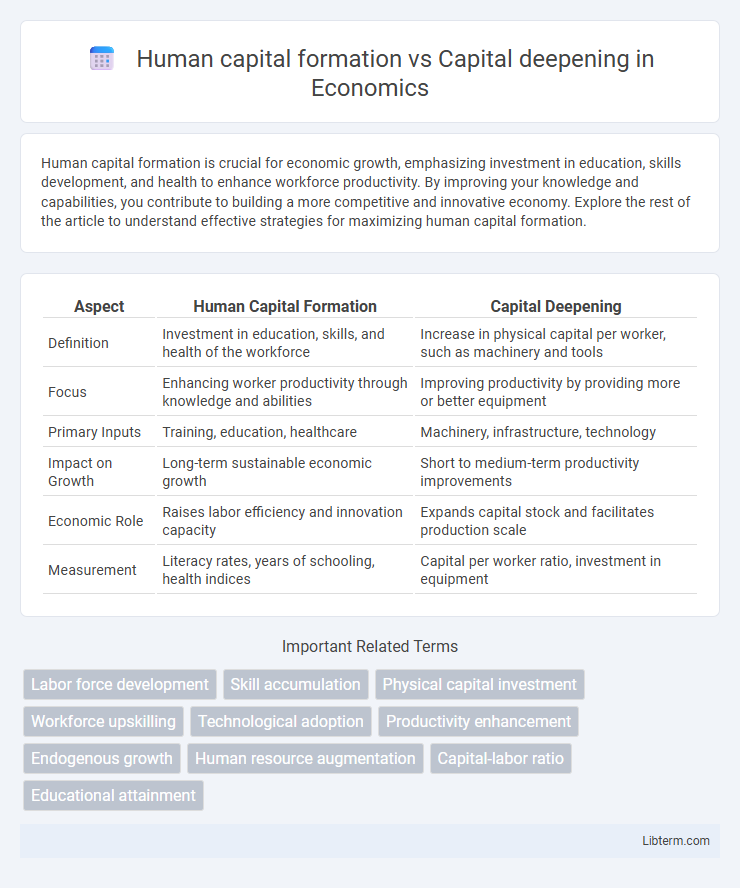Human capital formation is crucial for economic growth, emphasizing investment in education, skills development, and health to enhance workforce productivity. By improving your knowledge and capabilities, you contribute to building a more competitive and innovative economy. Explore the rest of the article to understand effective strategies for maximizing human capital formation.
Table of Comparison
| Aspect | Human Capital Formation | Capital Deepening |
|---|---|---|
| Definition | Investment in education, skills, and health of the workforce | Increase in physical capital per worker, such as machinery and tools |
| Focus | Enhancing worker productivity through knowledge and abilities | Improving productivity by providing more or better equipment |
| Primary Inputs | Training, education, healthcare | Machinery, infrastructure, technology |
| Impact on Growth | Long-term sustainable economic growth | Short to medium-term productivity improvements |
| Economic Role | Raises labor efficiency and innovation capacity | Expands capital stock and facilitates production scale |
| Measurement | Literacy rates, years of schooling, health indices | Capital per worker ratio, investment in equipment |
Introduction to Human Capital Formation and Capital Deepening
Human capital formation involves investing in education, training, and health to enhance the productivity and skills of the workforce, which directly improves labor quality and contributes to economic growth. Capital deepening refers to increasing the amount of physical capital per worker, such as machinery and technology, which boosts labor efficiency and output. Both concepts are vital for development as human capital focuses on enhancing worker capabilities, while capital deepening emphasizes improving the tools workers use.
Defining Human Capital Formation
Human capital formation refers to the process of improving individuals' skills, knowledge, and health through education, training, and healthcare, thereby enhancing workforce productivity and economic growth. Unlike capital deepening, which involves increasing physical assets like machinery or infrastructure per worker, human capital formation emphasizes investments in people to boost their capabilities. Effective human capital formation leads to a skilled labor force that can adapt to technological changes and drive innovation.
Understanding Capital Deepening
Capital deepening refers to the increase in the amount of capital per worker, enhancing labor productivity by equipping workers with more or better-quality tools, machinery, and technology. This process directly boosts output by improving the efficiency and effectiveness of the production process, driving economic growth. Unlike human capital formation, which emphasizes skills and education, capital deepening focuses on physical capital investments that augment worker capacity and production capabilities.
Key Differences between Human Capital and Physical Capital
Human capital formation involves investing in education, training, and health to enhance workers' skills and productivity, whereas capital deepening refers to increasing the amount of physical capital, such as machinery and equipment, per worker. Human capital emphasizes intangible assets like knowledge and abilities, while physical capital focuses on tangible assets used in production. The key differences lie in the nature of the capital--human capital boosts labor quality, whereas physical capital improves labor quantity and efficiency.
Drivers of Human Capital Formation
Human capital formation is driven primarily by investments in education, healthcare, and skill development that enhance the productivity and capabilities of the workforce. Factors such as access to quality education, nutrition, and ongoing training programs play critical roles in increasing the knowledge and efficiency of individuals. In contrast, capital deepening focuses on increasing physical capital per worker, relying on technological advancements and machinery rather than human skills and expertise.
Factors Influencing Capital Deepening
Capital deepening refers to the increase in capital per worker, significantly influenced by factors such as technological advancements, investment in physical capital, and access to financial resources. Human capital formation, on the other hand, entails improving worker skills and education, which indirectly supports capital deepening by enhancing the productivity of capital investments. Key determinants of capital deepening include the availability of credit, government policies promoting investment, and the overall economic environment fostering innovation and infrastructure development.
Economic Impact: Human Capital vs Capital Deepening
Human capital formation enhances labor productivity through education, skills development, and health improvements, leading to sustainable long-term economic growth by fostering innovation and adaptability. Capital deepening, which involves increasing the amount of physical capital per worker, boosts output by enabling more efficient production processes and technology use but may encounter diminishing returns without concurrent skill upgrades. Economies that balance human capital formation with capital deepening experience stronger and more resilient economic development due to the synergistic effects on workforce efficiency and technological advancement.
Case Studies: Comparative Analysis across Economies
Human capital formation emphasizes investments in education, skills, and health to enhance labor productivity, while capital deepening focuses on increasing physical capital per worker. Comparative analysis across economies reveals that countries like South Korea prioritized human capital formation through widespread education reforms, leading to rapid technological adoption, whereas capital deepening drove growth in resource-rich nations like Saudi Arabia via infrastructure and machinery expansion. Empirical case studies demonstrate that balanced integration of human capital development and capital deepening yields sustained economic growth and innovation capacity.
Challenges and Barriers to Each Approach
Human capital formation faces challenges such as inadequate access to quality education, skill mismatches, and limited investment in training infrastructure, hindering workforce productivity enhancement. Capital deepening encounters barriers including high costs of technological adoption, depreciation of physical assets, and resistance to upgrading machinery in established industries. Both approaches struggle with resource constraints and policy implementation gaps that slow overall economic development.
Policy Implications and Future Directions
Human capital formation emphasizes investing in education, skills, and health, driving productivity through a more capable workforce, which requires policies that prioritize lifelong learning, healthcare access, and skill development programs. Capital deepening involves increasing the amount of physical capital per worker, demanding policies that focus on infrastructure investment, technology adoption, and efficient capital allocation. Future directions should integrate digital innovation with human capital strategies, promoting adaptive learning environments and smart infrastructure to sustain economic growth.
Human capital formation Infographic

 libterm.com
libterm.com